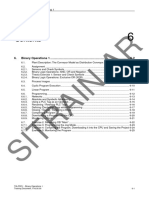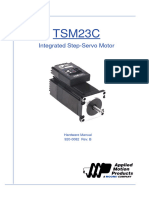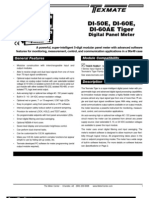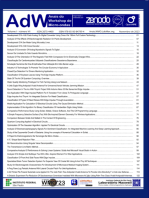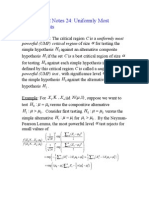10 Analog Value Processing
Uploaded by
joneschn10 Analog Value Processing
Uploaded by
joneschnSIMATIC S7-1200 Advanced Course
Contents 3
a
3. Analog value processing ....................................................................................... 3-2
3.1. Objectives ............................................................................................................................. 3-2
3.2. Task description .................................................................................................................... 3-3
di
3.3. Principle of analog value processing .................................................................................... 3-4
3.4. Properties of analog input modules ...................................................................................... 3-6
3.5. Properties of analog output modules .................................................................................... 3-8
In
3.6. Analog value representation and measured value resolution ............................................. 3-10
3.7. Analog value representation of different measuring ranges ............................................... 3-11
3.8. Analog value representation for the analog outputs ........................................................... 3-12
3.9. Scaling analog inputs with NORM_X and SCALE_X (1) .................................................... 3-13
3.9.1. Scaling analog inputs with NORM_X and SCALE_X (2) .................................................... 3-14
3.10. Controlling analog outputs with NORM_X and SCALE_X .................................................. 3-15
N
3.11. Comparator operations: IN_RANGE and OUT_RANGE .................................................... 3-16
AI
TR
SI
TIA-MICRO2 - Analog Value Processing 3-1
Training Document V16.00.00
SIMATIC S7-1200 Advanced Course
3. Analog value processing
3.1. Objectives
At the end of the chapter the participant will ...
a
… be familiar with the principle of analog value processing
... be able to assign parameters to an analog module
... be able to address an analog module
di
... be able to interpret the resolution of a module
… be familiar with the operations for the analog value conversion
… be able to program a simple analog value conversion
In
... be able to evaluate the diagnostics interrupt of the analog module
N
Objectives
In this chapter, the principle of analog value processing is presented. The goal is that the
AI
participant can parameterize an analog module and of interpreting the resolution.
Furthermore, the necessary conversion operations are presented to be able to process an analog
value. The participant should be able to program a simple analog value conversion and be able to
interpret a diagnostics interrupt of an analog module.
TR
SI
3-2 TIA-MICRO2 - Analog Value Processing
Training Document V16.00.00
SIMATIC S7-1200 Advanced Course
3.3. Principle of analog value processing
Process Analog input module User program
Physical Standard Read in the result memory into the Process
quantity analog signal image input table (PII) at the beginning of the
cycle
Sensor Transducer Result
memory Direct I/O access
ADC
a
• Pressure ± 500mV 0 0
• Temperature ± 1V IW96:P #temp IW96 #temp
• Flow ± 5V 27648 27648
di
• Speed ± 10V
• pH value ± 20mA
• Viscosity 4 to 20mA Analog output module
• etc. etc.
0.0 0.0
#temp QW80:P #temp QW80
1.0 1.0
In
Direct I/O access
Conversion
Physical Standard memory Output the Process image output table (PIQ) at
DAC the end of the cycle to the analog output
quantity analog signal
module
N
Principle of analog value processing
In a production process, there are a variety of physical quantities (such as pressure, temperature,
speed, rotational speed, pH value, and viscosity etc.) that need to be processed in the PLC for
automation purposes.
AI
Sensor
Measuring sensors respond to changes in the quantity to be measured by such things as linear
expansion, angular ductability, and alteration of electrical conductivity.
Transducer
TR
Measuring transducers convert these above-mentioned changes into standard analog signals,
such as: ± 500mV, ± 10V, ± 20mA, 4 to 20mA.
These signals are supplied to the analog input modules.
ADC
Before these analog values can be processed in the CPU, they must be converted to digital form.
The ADC (Analog-to-Digital Converter) on the analog input module handles this conversion.
The analog-to-digital conversion is performed sequentially. This means the signals are converted
SI
for each analog input channel in turn.
Result memory
The result of the conversion is stored in the result memory and remains there until it is overwritten
by a new value.
You can use the "IW...:P” addressing to read the converted analog value directly from the I/O.
3-4 TIA-MICRO2 - Analog Value Processing
Training Document V16.00.00
SIMATIC S7-1200 Advanced Course
Analog output
The (MOVE) transfer instruction is used to write the analog values the user program calculated to
an analog output module, where a DAC (Digital-to-Analog Converter) converts them to standard
analog signals.
Analog Actuators
You can connect standard actuators directly to the analog output modules.
Analog value conversion <-> physical unit
a
For this purpose there are system blocks in converters in the task card "instructions”: NORM_X,
SCALE_X,
Direct peripheral access ":P"
di
Direct peripheral access is identified by the ":P" addition, which can be programmed in
conjunction with the absolute address or symbolic name of the analog channel.
• Reading: current instantaneous value of the analog channel is read
• Writing: output value to the analog channel becomes process effective immediately
In
Access via process image
• Reading: The value "frozen for one cycle" from the process image of the inputs is read. This
is the value on the AI module at the beginning of the CPU cycle or start of an OB.
• - Writing: The present value is written into the process image of the outputs. This value is only
written to the AA module after the cycle or the parameterized OB has ended and only then is
N
it effective in the process.
AI
TR
SI
TIA-MICRO2 - Analog Value Processing 3-5
Training Document V16.00.00
SIMATIC S7-1200 Advanced Course
3.4. Properties of analog input modules
a
di
In
N
Analog input modules
In STEP7, analog input modules are configured and assigned parameters in the Device
configuration of the respective PLC. The settings or parameters of all modules are downloaded
into the CPU. The CPU must be in the STOP state to do this. In a subsequent CPU warm restart,
the CPU transfers these parameters to the relevant modules.
AI
Parameters
For the respective module, differentiation is made between module parameters and channel
parameters.
Module parameters
TR
• General
Name and comment for the integrated analog inputs of the CPU.
• Noise Reduction
In the noise reduction, the noise frequencies of the specified frequency (in Hz) are
suppressed by the integration time which is set.
• I/O Addresses and Hardware Identifier
The address space of the entry addresses as well as the process image is defined. The
SI
hardware identity of the device is displayed.
3-6 TIA-MICRO2 - Analog Value Processing
Training Document V16.00.00
SIMATIC S7-1200 Advanced Course
Channel parameters
• Measurement type
The type of measurement, such as voltage, is set with this parameter. An unused channel
must then be deactivated since it is otherwise also converted which would result in a longer
total conversion time of the module.
• Measuring Range (in the picture – Voltage range)
With this parameter, the measuring range of the selected type of measurement is set.
• Smoothing
a
The smoothing of analog values generates a stable analog signal for further processing.
Smoothing the analog values is recommended in case of fast signal changes (measured
value changes), for example, in the level measurement of fluctuating liquids.
• Underflow Diagnostics
di
Through this parameter, the underflow diagnostics is activated. If the measured value falls
below the underflow range of the channel, a diagnostic interrupt is triggered.
• Overflow Diagnostics
Through this parameter, the overflow diagnostics is activated. If the measured value exceeds
In
the overflow range of the channel, a diagnostic interrupt is triggered.
N
AI
TR
SI
TIA-MICRO2 - Analog Value Processing 3-7
Training Document V16.00.00
SIMATIC S7-1200 Advanced Course
3.5. Properties of analog output modules
a
di
In
N
Analog output modules
In STEP7, analog output modules are configured and assigned parameters in the Device
configuration of the respective PLC. The settings or parameters of all modules are downloaded
into the CPU. The CPU must be in the STOP state to do this. In a subsequent CPU warm restart,
the CPU transfers these parameters to the relevant modules.
AI
Parameters
For the respective module, differentiation is made between module parameters and channel
parameters.
Module parameters
TR
• General
Name and comment for the integrated analog outputs of the CPU.
• Reaction to CPU STOP
− Use substitute value
The peripheral device outputs the value previously set for the channel.
− Keep last value
The peripheral device retains the value last put out before STOP.
SI
Caution!
Make sure that the system is always in safe mode in the case of "Keep last value"!
• I/O Addresses and Hardware Identifier
The address space of the entry addresses as well as the process image is defined. The
hardware identity of the device is displayed.
3-8 TIA-MICRO2 - Analog Value Processing
Training Document V16.00.00
SIMATIC S7-1200 Advanced Course
Channel Parameters
• Output Type
The type of output, such as voltage, is set with this parameter. Unused outputs must be
deactivated since these are otherwise also converted which would result in a longer total
conversion time of the module.
• Output Range (in the picture – Voltage range)
The output range of the selected type of output is set with this parameter.
• Broken Wire Diagnostics (in Current mode)
a
With this parameter, the diagnostic Wire break is generated when there is a wire break. This
diagnostic is not noticeable in the zero range.
• Short-circuit Diagnostics (in Voltage mode)
With this parameter, a diagnostic is generated when there is a short-circuit of the output wire.
di
This diagnostic is not noticeable in the zero range.
• Overload Diagnostics
With this parameter, a diagnostic is generated when there is an overload.
• Substitute value
In
With this parameter, a substitute value is specified which the module is to output when the
CPU goes into STOP. The substitute value must be in the rated range, the over range or the
under range.
N
AI
TR
SI
TIA-MICRO2 - Analog Value Processing 3-9
Training Document V16.00.00
SIMATIC S7-1200 Advanced Course
3.6. Analog value representation and measured value resolution
Bit no. min. units 15 14 13 12 11 10 9 8 7 6 5 4 3 2 1 0
Bit value Dec. Hex. VZ 214 213 212 211 210 29 28 27 26 25 24 23 22 21 20
8 128 80 * * * * * * * * * 0 0 0 0 0 0 0
a
9 64 40 * * * * * * * * * * 0 0 0 0 0 0
10 32 20 * * * * * * * * * * * 0 0 0 0 0
Reso-
di
lution 11 16 10 * * * * * * * * * * * * 0 0 0 0
in bits
+ sign 12 8 8 * * * * * * * * * * * * * 0 0 0
(VZ)
13 4 4 * * * * * * * * * * * * * * 0 0
In
14 2 2 * * * * * * * * * * * * * * * 0
15 1 1 * * * * * * * * * * * * * * * *
* = 0 or 1
N
Representation
Negative analog values are represented as the two's complement.
The value is positive if bit No. 15=0 and negative if bit No.15=1.
Resolution
AI
If the resolution of an analog module is less than 16 bits, the analog value is written into the
accumulator (module result memory) left-justified. The unused less significant bit positions are
filled with "0"s.
Accuracy
TR
Resolutions of between 8 and 16 bits are possible, depending on the type of module.
SI
3-10 TIA-MICRO2 - Analog Value Processing
Training Document V16.00.00
SIMATIC S7-1200 Advanced Course
3.7. Analog value representation of different measuring ranges
Voltage Current Resistance Temperature
such as: such as: such as: e.g. Pt100 (Standard)
Range
Meas.range Meas.range Meas.range Meas.range
± 10V Units 4 to 20mA Units 0 to300Ohm Units -200 to+850ºC Units
a
Overflow >= 11.76 32767 >= 22.815 32767 >=352.778 32767 >= 1000.1 32767
11.7589 32511 22.810 32511 352.767 32511 1000.0 10000
Over range : : : : : : : :
10.0004 27649 20.0005 27649 300.011 27649 850.1 8501
di
10.00 27648 20.000 27648 300.000 27648 850.0 8500
7.50 20736 16.000 20736 225.000 20736 : :
Rated range : : : : : :
: :
-7.5 -20736 : : : : : :
-10.00 -27648 4.000 0 0.000 0 -200.0 -2000
In
- 10.0004 - 27649 3.9995 -1 -1 - 200.1 - 2001
negative
Under range : : : : : : :
values
- 11.759 - 32512 1.1852 - 4864 - 4864 - 243.0 - 2430
not
Underflow <= - 11.76 - 32768 <= 1.1845 - 32768 possible - 32768 <= - 243.1 - 32768
N
Voltage, Current (Symmetrical)
Converting the symmetrical voltage or current ranges results in a rated range of -27648 to
+27648.
• ± 80mV • ± 2,5 V • ± 3,2 mA
AI
• ± 250 mV • ± 5V • ± 10 mA
• ± 500 mV • ± 10V • ± 20 mA
• ±1V
Voltage, Current (Asymmetrical)
Converting the asymmetrical voltage or current ranges results in a rated range of 0 to +27648.
TR
• 0 ... 2 V • 0 ... 20 mA
• 1 ... 5 V • 4 ... 20 mA
Resistance
Converting the resistance ranges results in a rated range of 0 to +27648.
• 0 to 150 Ohm
• 0 to 300 Ohm
• 0 to 600 Ohm
SI
Temperature
Temperatures are measured with resistance thermometers or thermocouples. Converting results
in a rated range of ten times the temperature range
TIA-MICRO2 - Analog Value Processing 3-11
Training Document V16.00.00
SIMATIC S7-1200 Advanced Course
3.8. Analog value representation for the analog outputs
Voltage Current
Range Units
Output ranges: Output ranges:
0 to 10V 1 to 5V ± 10V 0 to 20mA 4 to 20mA ± 20mA
Overflow >=32767 0 0 0 0 0 0
32511 11.7589 5.8794 11.7589 23.515 22.81 23.515
Over range : : : : : : :
a
27649 10.0004 5.0002 10.0004 20.0007 20.005 20.0007
27648 10.0000 5.0000 10.0000 20.000 20.000 20.000
: : : : : : :
0 0 1.0000 0 0 4.000 0
di
: : :
0 0.9999 0 3.9995
Rated range - 6912 : :
: :
- 6913 0 : 0 :
: : :
: 0 : 0 :
: : :
In
- 27648 -10.0000 -20.000
- 27649 - 10.0004 - 20.007
Under range : : :
- 32512 - 11.7589 - 23.515
Underflow <=- 32513
0 0
N
Voltage, Current (Symmetrical)
For symmetrical voltage or current ranges, a rated range of -27648 to +27648 is converted to:
• ± 10V
• ± 20mA
AI
Voltage, Current (Asymmetrical)
For asymmetrical voltage or current ranges, a rated range of 0 to +27648 is converted to:
• 0 to 10V
•
TR
1 to 5V
• 0 to 20mA
• 4 to 20mA
Overflow
If the value to be converted reaches the overflow range, the analog output module is disabled
(0V, 0mA).
SI
3-12 TIA-MICRO2 - Analog Value Processing
Training Document V16.00.00
SIMATIC S7-1200 Advanced Course
3.9. Scaling analog inputs with NORM_X and SCALE_X (1)
NORM_X scales the input
A B
signal at input “Value” in
the limits “MIN and MAX”
to the signal range 0.0 to
1.0
a
Sensor supplies only positive voltages Sensor also supplies negative voltage
di
OUT OUT
MAX = 1.0 MAX = 1.0
In
A B
Δ
MIN = 0.0 MIN = 0.0
Value Value
x x+1 x x+1
0 27648 -27648
N
Norm_X
The analog module converts the voltage range of -10V to +10V into the value range of -27648 to
+27648. The "Normalize" instruction scales a value by mapping it to a linear scale. You can use
the MIN and MAX parameters to define the limits of a value range that is applied to the scale.
Depending on the position of this value to be scaled in the value range, the result is calculated
AI
and stored as a floating-point number. If the value to be scaled is equal to the value at the MIN
input, the instruction returns the value "0.0" as the result. If the value to be scaled is equal to the
value at the MAX input, the instruction supplies the result "1.0".
Resolution
In example B, the measurement occurs with twice the resolution or with half as much measuring
TR
tolerance Δ, since the measured value is mapped to the greater units range of -27648 to +27648.
Data Types
• The parameters on the input-side can be one of the following data types:
SINT, INT, DINT, USINT, UINT, UDINT or REAL
• The parameter OUT can be one of the following data types: REAL or LREAL
SI
Parameters
• VALUE: Value which is scaled
• MIN: Lower limit of the value range
• MAX: Upper limit of the value range
• OUT: Scaled signal 0.0 to 1.0
TIA-MICRO2 - Analog Value Processing 3-13
Training Document V16.00.00
SIMATIC S7-1200 Advanced Course
3.9.1. Scaling analog inputs with NORM_X and SCALE_X (2)
Sensor also supplies negative voltage
A B
OUT
300
a
Sensor supplies only positive voltages B
di
OUT
300 0
VALUE
0.0 1.0
0
0.0 1.0
VALUE
In -300
N
SCALE_X
The "Scale" instruction scales the value at the VALUE input linearly by mapping it to a specified
value range. When the "Scale" instruction is executed, the floating-point value at the VALUE input
is scaled to the value range which was defined by the MIN and MAX parameters. The result of
the scaling is an integer which is stored at the OUT output.
AI
Example
In the example shown, the value at the VALUE input is scaled within the limits 0 to 300 for case
A. In case B, VALUE is scaled to the limits -300 to 300.
TR
The VALUE input may only be within the limits 0.0 to 1.0!
Parameters
• VALUE: Value which is scaled
• MIN: Lower limit of the value range
• MAX: Upper limit of the value range
• OUT: Result of scaling
SI
3-14 TIA-MICRO2 - Analog Value Processing
Training Document V16.00.00
SIMATIC S7-1200 Advanced Course
3.10. Controlling analog outputs with NORM_X and SCALE_X
Example: Control valve 0 to 100%
Normalized signal is scaled to the
corresponding rated range, here 0 to
27648, of the actuator.
a
Calculated valve position in the
di
limits 0 to 100% is scaled to the
signal 0.0 to 1.0.
OUT OUT
1.0 27648
0.0
0 100
VALUE
In 0
0.0 1.0
VALUE
N
Controlling analog outputs (Example)
An analog value (valve position) calculated by the user program in the range 0 to 100% is
converted to the range 0 to +27648 through the combination of NORM_X and SCALE_X. In
outputting the unscaled value to an analog output module, it will control the analog actuator (for
example, a servo valve) with, for example, 0V to +10V (depending on the output range set).
AI
The example shows the scaling for an actuator that is to be controlled with the value 0 (0V or
0mA) when the program value is 0%, and with the maximum value (for example, +10V or 20mA)
when it is 100%.
TR
SI
TIA-MICRO2 - Analog Value Processing 3-15
Training Document V16.00.00
SIMATIC S7-1200 Advanced Course
3.11. Comparator operations: IN_RANGE and OUT_RANGE
a
di
In
100 500
IN_RANGE
OUT_RANGE
N
IN_RANGE
With the "Value within range" instruction you can query whether the value at the VAL input is
within a specific value range. You define the limits of the value range with the parameters MIN
and MAX. In executing the query, the "Value within range" instruction compares the value at the
VAL input with the values of the parameters MIN and MAX and assigns the result to the box
AI
output. If the value at the VAL input fulfills the comparison MIN <= VAL <= MAX, the box output
has signal state "1". When the comparison is not fulfilled, the box output has signal state "0".
The compare function is only executed if the values to be compared are of the same data type
and the box output is used.
OUT_RANGE
TR
With the "Value outside range" instruction you can query whether the value at the VAL input is
outside of a specific value range. The limits of the value range are defined through the
parameters MIN and MAX. In executing the query, the "Value outside range" instruction
compares the value at the VAL input with the values of the parameters MIN and MAX and
assigns the result to the box output. If the value at the VAL input fulfills the comparison MIN >
VAL or VAL > MAX, the box output has signal state "1". When the comparison is not fulfilled, the
box output has signal state "0".
The compare function is only executed if the values to be compared are of the same data type
SI
and the box output is used.
OK / NOT_OK
The OK (NOT_OK) instruction checks whether the value of the variable specified through the box
corresponds to a valid REAL or LREAL. If this is the case, the box supplies RLO '1' at its output.
3-16 TIA-MICRO2 - Analog Value Processing
Training Document V16.00.00
You might also like
- TIA Openness GettingStartedAndDemo V14SP1 en100% (1)TIA Openness GettingStartedAndDemo V14SP1 en35 pages
- Training Curriculum: TIA Portal Module 009No ratings yetTraining Curriculum: TIA Portal Module 00927 pages
- s7 Plcs and Applications - Lesson 3 - Analog ProcessNo ratings yets7 Plcs and Applications - Lesson 3 - Analog Process69 pages
- Analog Interfacing Overview: Analog and Digital Signals Analog Interfacing MKL25Z Analog ModulesNo ratings yetAnalog Interfacing Overview: Analog and Digital Signals Analog Interfacing MKL25Z Analog Modules54 pages
- PIC16/PIC18 ADC Technical Brief: 2018 Microchip Technology Inc. 90003194a-Page 1No ratings yetPIC16/PIC18 ADC Technical Brief: 2018 Microchip Technology Inc. 90003194a-Page 127 pages
- S15 App Note 3.4.0 4-20ma Automatic Start and StopNo ratings yetS15 App Note 3.4.0 4-20ma Automatic Start and Stop6 pages
- Handy Calibrator: Multi-Functional Hand-Held CalibratorNo ratings yetHandy Calibrator: Multi-Functional Hand-Held Calibrator4 pages
- Wenling Yuhai Electromechanical 180sy-M35015 Sg-50a DatasheetNo ratings yetWenling Yuhai Electromechanical 180sy-M35015 Sg-50a Datasheet62 pages
- Lab 2 Analog Input and Output: ComponentsNo ratings yetLab 2 Analog Input and Output: Components5 pages
- HTTPS: - WWW - Electrical4u.com - Analog-To-Digital-ConverterNo ratings yetHTTPS: - WWW - Electrical4u.com - Analog-To-Digital-Converter9 pages
- DSG-1201 SERIES Digital/Bar-Graph Tachometer/Speed Switch: Certified Class I, Divisions 1 and 2, Group DNo ratings yetDSG-1201 SERIES Digital/Bar-Graph Tachometer/Speed Switch: Certified Class I, Divisions 1 and 2, Group D2 pages
- Dr.S.Vijayaraghavan Embedded Systems Design LabNo ratings yetDr.S.Vijayaraghavan Embedded Systems Design Lab37 pages
- S7-1200 Programmable Controller - Processing of Analog ValuesNo ratings yetS7-1200 Programmable Controller - Processing of Analog Values2 pages
- Making PIC Microcontroller Instruments and ControllersFrom EverandMaking PIC Microcontroller Instruments and ControllersNo ratings yet
- SQL Express Scripting From Wincc AdvancedNo ratings yetSQL Express Scripting From Wincc Advanced12 pages
- POLYTECHNIC LECTURERS Differential EquationsNo ratings yetPOLYTECHNIC LECTURERS Differential Equations10 pages
- Church's Year of Grace - Volume 1 Advent To CandlemasNo ratings yetChurch's Year of Grace - Volume 1 Advent To Candlemas510 pages
- Building Your Theology - Lesson 4 - TranscriptNo ratings yetBuilding Your Theology - Lesson 4 - Transcript24 pages
- Ambikapathi-Amaravathi and Romeo-Juliet: A Comparative StudyNo ratings yetAmbikapathi-Amaravathi and Romeo-Juliet: A Comparative Study12 pages
- DP90 and Message "No Expenditure Items Found": SymptomNo ratings yetDP90 and Message "No Expenditure Items Found": Symptom2 pages
- A Radical Approach to Real Analysis 2nd Edition David Bressoud all chapter instant download100% (6)A Radical Approach to Real Analysis 2nd Edition David Bressoud all chapter instant download58 pages
- Session 02: IELTS P Reparation Cour Se Elsaid Rashad (MR Ha Ppy) IELTS 4 Arabs G Roup/ FBNo ratings yetSession 02: IELTS P Reparation Cour Se Elsaid Rashad (MR Ha Ppy) IELTS 4 Arabs G Roup/ FB15 pages
- Language Acquisition and Language LearningNo ratings yetLanguage Acquisition and Language Learning2 pages
- Evening Prayer (Vespers) in The English Parochial Tradition According To Orthodox Catholic UsageNo ratings yetEvening Prayer (Vespers) in The English Parochial Tradition According To Orthodox Catholic Usage4 pages
- Statistics 512 Notes 24: Uniformly Most Powerful Tests: X FX X FX X XNo ratings yetStatistics 512 Notes 24: Uniformly Most Powerful Tests: X FX X FX X X7 pages
- Billmeyer and Saltzman S Principles of Color Technology 4th Edition Roy S. Berns PDF Full Chapter100% (14)Billmeyer and Saltzman S Principles of Color Technology 4th Edition Roy S. Berns PDF Full Chapter24 pages
- Local/Remote Control 9600 Series ConverterNo ratings yetLocal/Remote Control 9600 Series Converter21 pages
- Organizational Behavior: Chapter No 11 CommunicationNo ratings yetOrganizational Behavior: Chapter No 11 Communication27 pages
- Primergy Serverview Suite: Irmc S2 - Integrated Remote Management Controller (Firmware Version 3.77A)No ratings yetPrimergy Serverview Suite: Irmc S2 - Integrated Remote Management Controller (Firmware Version 3.77A)532 pages
- s7 Plcs and Applications - Lesson 3 - Analog Processs7 Plcs and Applications - Lesson 3 - Analog Process
- Analog Interfacing Overview: Analog and Digital Signals Analog Interfacing MKL25Z Analog ModulesAnalog Interfacing Overview: Analog and Digital Signals Analog Interfacing MKL25Z Analog Modules
- PIC16/PIC18 ADC Technical Brief: 2018 Microchip Technology Inc. 90003194a-Page 1PIC16/PIC18 ADC Technical Brief: 2018 Microchip Technology Inc. 90003194a-Page 1
- S15 App Note 3.4.0 4-20ma Automatic Start and StopS15 App Note 3.4.0 4-20ma Automatic Start and Stop
- Handy Calibrator: Multi-Functional Hand-Held CalibratorHandy Calibrator: Multi-Functional Hand-Held Calibrator
- Wenling Yuhai Electromechanical 180sy-M35015 Sg-50a DatasheetWenling Yuhai Electromechanical 180sy-M35015 Sg-50a Datasheet
- HTTPS: - WWW - Electrical4u.com - Analog-To-Digital-ConverterHTTPS: - WWW - Electrical4u.com - Analog-To-Digital-Converter
- DSG-1201 SERIES Digital/Bar-Graph Tachometer/Speed Switch: Certified Class I, Divisions 1 and 2, Group DDSG-1201 SERIES Digital/Bar-Graph Tachometer/Speed Switch: Certified Class I, Divisions 1 and 2, Group D
- S7-1200 Programmable Controller - Processing of Analog ValuesS7-1200 Programmable Controller - Processing of Analog Values
- Making PIC Microcontroller Instruments and ControllersFrom EverandMaking PIC Microcontroller Instruments and Controllers
- Church's Year of Grace - Volume 1 Advent To CandlemasChurch's Year of Grace - Volume 1 Advent To Candlemas
- Ambikapathi-Amaravathi and Romeo-Juliet: A Comparative StudyAmbikapathi-Amaravathi and Romeo-Juliet: A Comparative Study
- DP90 and Message "No Expenditure Items Found": SymptomDP90 and Message "No Expenditure Items Found": Symptom
- A Radical Approach to Real Analysis 2nd Edition David Bressoud all chapter instant downloadA Radical Approach to Real Analysis 2nd Edition David Bressoud all chapter instant download
- Session 02: IELTS P Reparation Cour Se Elsaid Rashad (MR Ha Ppy) IELTS 4 Arabs G Roup/ FBSession 02: IELTS P Reparation Cour Se Elsaid Rashad (MR Ha Ppy) IELTS 4 Arabs G Roup/ FB
- Evening Prayer (Vespers) in The English Parochial Tradition According To Orthodox Catholic UsageEvening Prayer (Vespers) in The English Parochial Tradition According To Orthodox Catholic Usage
- Statistics 512 Notes 24: Uniformly Most Powerful Tests: X FX X FX X XStatistics 512 Notes 24: Uniformly Most Powerful Tests: X FX X FX X X
- Billmeyer and Saltzman S Principles of Color Technology 4th Edition Roy S. Berns PDF Full ChapterBillmeyer and Saltzman S Principles of Color Technology 4th Edition Roy S. Berns PDF Full Chapter
- Organizational Behavior: Chapter No 11 CommunicationOrganizational Behavior: Chapter No 11 Communication
- Primergy Serverview Suite: Irmc S2 - Integrated Remote Management Controller (Firmware Version 3.77A)Primergy Serverview Suite: Irmc S2 - Integrated Remote Management Controller (Firmware Version 3.77A)











